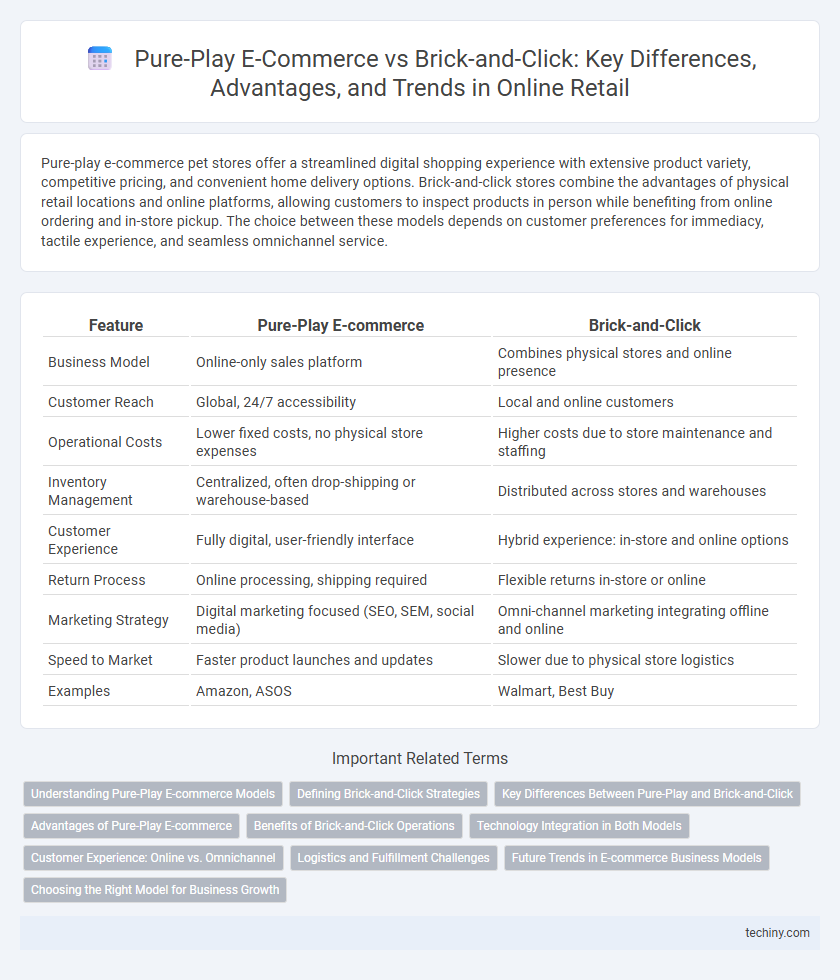Pure-play e-commerce pet stores offer a streamlined digital shopping experience with extensive product variety, competitive pricing, and convenient home delivery options. Brick-and-click stores combine the advantages of physical retail locations and online platforms, allowing customers to inspect products in person while benefiting from online ordering and in-store pickup. The choice between these models depends on customer preferences for immediacy, tactile experience, and seamless omnichannel service.
Table of Comparison
| Feature | Pure-Play E-commerce | Brick-and-Click |
|---|---|---|
| Business Model | Online-only sales platform | Combines physical stores and online presence |
| Customer Reach | Global, 24/7 accessibility | Local and online customers |
| Operational Costs | Lower fixed costs, no physical store expenses | Higher costs due to store maintenance and staffing |
| Inventory Management | Centralized, often drop-shipping or warehouse-based | Distributed across stores and warehouses |
| Customer Experience | Fully digital, user-friendly interface | Hybrid experience: in-store and online options |
| Return Process | Online processing, shipping required | Flexible returns in-store or online |
| Marketing Strategy | Digital marketing focused (SEO, SEM, social media) | Omni-channel marketing integrating offline and online |
| Speed to Market | Faster product launches and updates | Slower due to physical store logistics |
| Examples | Amazon, ASOS | Walmart, Best Buy |
Understanding Pure-Play E-commerce Models
Pure-play e-commerce refers to businesses that operate exclusively online without any physical storefronts, leveraging digital channels for marketing, sales, and customer engagement. These models prioritize streamlined online user experiences, data-driven personalization, and scalable logistics to reduce overhead costs and expand market reach. Understanding pure-play e-commerce helps identify advantages like lower operational expenses and faster adaptation to consumer trends compared to brick-and-click retailers, which blend physical stores with online platforms.
Defining Brick-and-Click Strategies
Brick-and-click strategies integrate physical retail locations with online sales platforms, enabling seamless customer experiences across channels. Retailers leverage in-store inventory for faster order fulfillment, offer buy-online-pickup-in-store (BOPIS) services, and gather comprehensive consumer data to personalize marketing efforts. This hybrid model enhances brand presence, drives cross-channel sales, and improves customer retention compared to pure-play e-commerce businesses operating solely online.
Key Differences Between Pure-Play and Brick-and-Click
Pure-play e-commerce businesses operate exclusively online, relying on digital platforms for sales, marketing, and customer engagement, which allows for lower overhead costs and broader market reach. Brick-and-click models integrate both physical storefronts and online channels, providing customers with a seamless shopping experience through in-person and digital interaction, enhancing trust and immediate product access. Key differences include inventory management, customer service approach, and scalability potential, with pure-play favoring agility and lower operational complexity, while brick-and-click benefits from omnichannel presence and local market penetration.
Advantages of Pure-Play E-commerce
Pure-play e-commerce businesses benefit from lower operational costs by eliminating the need for physical retail space, enabling competitive pricing and higher profit margins. They can rapidly scale and adapt to market trends using data-driven insights and digital marketing strategies to enhance customer targeting and personalization. The streamlined online-only model allows for 24/7 global accessibility, providing consumers with convenience and a seamless shopping experience unavailable in traditional brick-and-click setups.
Benefits of Brick-and-Click Operations
Brick-and-click operations combine the convenience of online shopping with the tangible experience of physical stores, enhancing customer trust and brand loyalty. They enable seamless inventory management and faster fulfillment through integrated supply chains, reducing delivery times and operational costs. Offering both digital and in-store channels expands market reach and provides diverse revenue streams, improving overall business resilience in competitive e-commerce landscapes.
Technology Integration in Both Models
Pure-play e-commerce businesses leverage cutting-edge digital tools, cloud computing, and AI-driven analytics to optimize online customer experiences and streamline operations without physical storefront constraints. Brick-and-click models integrate technology to synchronize inventory management, omnichannel marketing, and seamless customer service between online platforms and physical stores. These technological integrations enhance real-time data visibility, improve supply chain efficiency, and foster personalized consumer engagement across both commerce strategies.
Customer Experience: Online vs. Omnichannel
Pure-play e-commerce platforms offer streamlined online shopping experiences with fast navigation and digital personalization, enhancing convenience and accessibility. Brick-and-click retailers integrate physical stores with online channels, providing customers flexible options like in-store pickup, returns, and personalized assistance for a seamless omnichannel experience. The omnichannel approach leverages multiple touchpoints to improve customer engagement, satisfaction, and loyalty compared to purely online interactions.
Logistics and Fulfillment Challenges
Pure-play e-commerce businesses rely heavily on advanced logistics networks to ensure rapid fulfillment and delivery, facing challenges in last-mile delivery efficiency and inventory management across decentralized warehouses. Brick-and-click retailers must coordinate between physical stores and online channels, complicating stock allocation and return processes, often requiring integrated systems to synchronize sales data and optimize fulfillment routes. Both models encounter obstacles in scaling operations to meet fluctuating consumer demand while maintaining cost-effective shipping and minimizing delivery times.
Future Trends in E-commerce Business Models
Pure-play e-commerce businesses are increasingly adopting AI-driven personalization and advanced analytics to enhance customer experiences, while brick-and-click models focus on integrating seamless omnichannel strategies that merge physical and digital shopping. Future trends emphasize the rise of augmented reality (AR) for immersive product interactions and the use of blockchain for secure, transparent transactions across both models. Leveraging these technologies, e-commerce businesses aim to optimize supply chains, improve customer retention, and expand global reach effectively.
Choosing the Right Model for Business Growth
Pure-play e-commerce businesses operate exclusively online, enabling lower operational costs and broader market reach, making them ideal for startups and rapidly scalable ventures. Brick-and-click models combine physical stores with online platforms, offering customers the advantage of in-person experiences alongside digital convenience, which enhances brand trust and customer loyalty. Selecting the optimal model depends on factors like target audience, budget, and growth strategy, with pure-play suited for aggressive online expansion and brick-and-click favorable for businesses aiming to integrate omnichannel retail.
Pure-play E-commerce vs Brick-and-click Infographic

 techiny.com
techiny.com